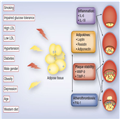Abstract and Introduction
Abstract
Extensive research in recent decades has revealed manifold metabolic functions of adipose tissue, beyond its purpose as a simple storage organ for fatty acids. Consequently, proinflammatory mediators have been identified that actively promote atherosclerosis. This review therefore highlights the complex interactions between selected cytokines and mediators originating from adipose tissue and atherothrombosis.
Introduction
Cardiovascular disease (CVD) accounts for one of every three deaths in the USA today, both in men and women.[1] Among the contributing major cardiovascular risk factors, an increased waistline, elevated triglycerides (TGs), impaired fasting plasma glucose, high systolic blood pressure and low levels of HDL cholesterol are referred to as metabolic syndrome (MetS).[2] According to the updated definitions by the Adult Treatment Panel III, three or more of these components define the presence of MetS.[3] Whereas the original definition by Reaven (1988), as well as the definition by WHO (1998), emphasized insulin resistance as mandatory for the diagnosis, the role of central obesity, measured by waist circumference, has gained increasing attention and is compulsory for the International Diabetes Federation criteria [;[3–7] TRøSEIDM, UNPUBLISHED DATA]. In 2009, the aforementioned major organizations attempted to unify the criteria for MetS and released a joint definition without an obligatory component. Therefore, three out of the following five findings would qualify a person for the syndrome: elevated waist circumference (according to population-specific definitions), elevated TGs (≥150 mg/dl, 1.7 mmol/l), reduced HDL concentrations (<40 mg/dl [1 mmol/l] in males and <50 mg/dl, [1.4 mmol/l] in females), elevated blood pressure (≥130/85 mmHg) and elevated fasting glucose (≥100 mg/dl, 5.6 mmol/l).[8]
Obesity is a growing burden worldwide, hence, forecasts predict an increase in prevalence from 35%, to date, to 51% by 2030 in US Americans.[1,9]
Indeed, adipose tissue is not longer regarded as a simple long-term storage organ for fatty acids but rather appreciated as an important player in the metabolism of lipids and glucose, since numerous hormones and proinflammatory cytokines are released from adipocytes themselves, macrophages, fibroblasts and endothelial cells.[10,11] In the present review we want to shed light on the complex interactions between selected cytokines and mediators originating from adipose tissue and atherothrombosis (Figure 1).
Figure 1.
The complex crosslink between comorbidities, lifestyle factors and proinflammatory changes, subsequently leading to atherothrombosis.
PAI: Plasminogen activator inhibitor; TIMP: Tissue inhibitor of metalloproteinase.
Clin Lipidology. 2014;9(1):71-81. © 2014 Future Medicine Ltd.










